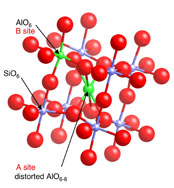Dynamics in Crystalline and Molten Silicates and Oxides
NMR has long been used to explore the dynamics of atomic and molecular motions in solids and liquids, being uniquely sensitive to frequencies of that often control processes such as diffusion, viscous transport, and phase transitions, roughly from the second to the 10's of nanoseconds time scales. At the "slow" end of this range, motions such as exchange of cations among distinct sites in a crystal, or of oxide anions among different bonding environments (e.g. bridging vs. non-bridging) in a crystal or a viscous melt, may be directly observable as the motional averaging of distinct peaks in a high resolution NMR spectrum. At the "fast" end of the range, molecular and atomic motions near to the Larmor frequency of the nuclide of interest (10's to 100's of MHz) can control spin-lattice relaxation, so measurements of relaxation rates can constrain models of dynamics. For many years we have used special, in-situ high temperature NMR probes, either designed and constructed in our lab ("static" samples, to 1500 C) or by Doty Scientific, Inc. (MAS to 700 C), to study dynamics in both crystalline and molten silicates, oxides, and fluorides.


